Nir David
Nir David (Hebrew: נִיר דָּוִד, lit. David's Meadow) is a kibbutz in the Beit She'an Valley in northern Israel. Founded on 10 December 1936 as Tel Amal, the first of the tower and stockade settlements, it falls under the jurisdiction of Valley of Springs Regional Council. In 2019 it had a population of 729.[1]
Nir David נִיר דָּוִד | |
|---|---|
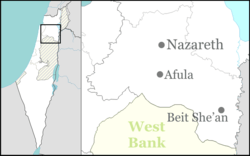 Nir David  Nir David | |
| Coordinates: 32°30′13″N 35°27′26″E | |
| Country | |
| District | Northern |
| Council | Valley of Springs |
| Affiliation | Kibbutz Movement |
| Founded | 1936 |
| Founded by | Hashomer Hatzair founders |
| Population (2019)[1] | 729 |
| Name meaning | David’s Meadow |
| Website | www.nir-david.org.il |
History
_IN_THE_BEIT_SHEAN_VALLEY._%D7%A6%D7%99%D7%9C%D7%95%D7%9D_%D7%90%D7%95%D7%95%D7%99%D7%A8_%D7%A9%D7%9C_%D7%A7%D7%99%D7%91%D7%95%D7%A5_%D7%AA%D7%9C_%D7%A2%D7%9E%D7%9C_(%D7%A0%D7%99%D7%A8_%D7%93%D7%95%D7%93)_%D7%91%D7%A2%D7%9E%D7%A7_%D7%91%D7%99%D7%AA_%D7%A9%D7%90%D7%9F.D828-019.jpg)
The Nir David pioneering group was formed in the city of Ramat Gan in 1932. Its first members were founders of the local chapter of Hashomer Hatzair Zionist youth movement. In 1933, the group united with kibbutz "Massad" from Poland (no connection with the Massad city from the Lower Galilee, nor with the "Massad" group which founded nearby kibbutz Kfar Ruppin, since that one consisted of refugees from Germany and Austria who arrived in 1933-1934; "Massad" means "foundation" in Hebrew).
In 1934, the community sent a group to the Beit She'an Valley to cultivate the land that the Jewish National Fund had purchased for future settlements in the region. The kibbutz members began farming around Tel Shuk, where the kibbutz would later be established. When Arab revolt began on the night of 20 April 1936, the kibbutz's first wheat crop was burned and its plants and seedlings uprooted.
The Jewish residents were determined to return to their land, despite the dangers involved. Faced with Arab hostility and British opposition, they devised a plan for a fortified settlement that could resist attack.
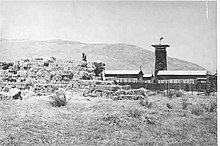
On 10 December 1936, Tel Amal was established as the first tower and stockade settlement (and the first kibbutz) in the Beit She'an Valley,[2] and the second in all of Mandate Palestine after Kfar Hittim. During the next three years of troubles from the 1936–39 Arab revolt, some 52 such settlements were built overnight.
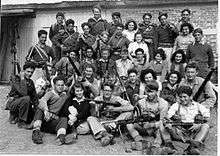
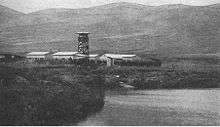
In the 1940s, the kibbutz was renamed Nir David in honor of David Wolfsohn, second president of the World Zionist Organization. The communal dining room and two children's homes were designed by Zeev Rechter, architect of some of Israel's most iconic buildings.[3]
Nir David uses land that traditionally belonged to the depopulated Palestinian village of Al-Sakhina.[4]
Economy
The kibbutz's main income is from agriculture, e.g., field crops, orchards, and fish. Nir David Fish Breeding Farms has developed Tilapia strains with unique properties.[5] The kibbutz's "Nirotek" factory produces self adhesive and carbonless copy paper, and a metal factory exports horticultural vehicles and tools.
Landmarks
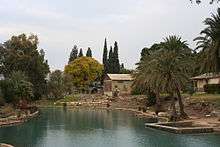
- "Gan Hashlosha" - A semi-natural water park (formerly known by its Arabic name, Sachne).
- "Gan-Garoo" - Australian zoo, which features Australian marsupial wildlife such as kangaroos and koala[6]
- Village Inn - Lodging in Nir-David on the banks of the Asi river.
- Guest ranch - a relatively large horse ranch offering horseback training for children and adults, from basic riding to competitive, and occasionally hosts equestrian show jumping competitions.
- Holtzer Sport Center - A modern sport complex which includes a 25 m. swimming pool, basketball court and a multipurpose sports auditorium.
See also
References
- "Population in the Localities 2019" (XLS). Israel Central Bureau of Statistics. Retrieved 16 August 2020.
- Bar-Am, Aviva; Bar-Am, Shmuel (February 28, 2015). "The gutsy little kibbutz with a river that runs through it". The Times of Israel. Retrieved April 29, 2019.
- Rosenblum, Keshet (November 29, 2002). "A Room with a View of Israel of Old". Haaretz. Retrieved April 29, 2019.
- Khalidi, W. (1992). All That Remains: The Palestinian Villages Occupied and Depopulated by Israel in 1948. Washington D.C.: Institute for Palestine Studies. p. 58. ISBN 0-88728-224-5.
- Tilapia brood stock
- Beidas, Nadia (March 22, 2009). "Green Eggs and Trees: Kibbutz Nir David". The Jerusalem Post. Retrieved April 29, 2019.
External links
- Official website
- Nir David Metal Works (in Hebrew)
- Nir David Tourism (in Hebrew)
- Gan Hashlosha